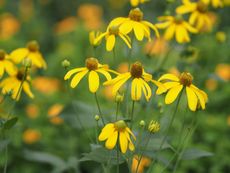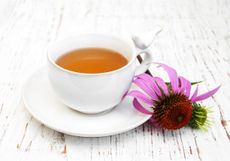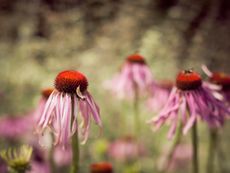Common Issues With Coneflowers: Coneflower Plant Diseases And Pests


Coneflowers (Echinacea) are popular wildflowers found in many gardens. These long-blooming beauties can be seen flowering from midsummer through fall. Although these plants are generally resistant to most pests and diseases, you may occasionally encounter issues with coneflowers.
Coneflower Pests
The most common insect pests that affect coneflowers include sweet potato whiteflies, aphids, Japanese beetles, and Eriophyid mites.
- Sweet potato whiteflies - Sweet potato whiteflies live and feed on the undersides of leaves, sucking out plant juices. Oftentimes, the presence of these pests results in the growth of black sooty mold. In addition, you may see leaf yellowing and shredding. Sweet potato whiteflies can also transfer diseases, such as vector viruses.
- Aphids - Aphids, like whiteflies, will suck the nutrients from plants. In large masses, they can quickly overwhelm and kill plants.
- Japanese beetles - Japanese beetles feed in groups and can usually be spotted around June. They will quickly destroy plants by feeding on foliage and flowers, starting at the top and working down.
- Eriophyid mites - Eriophyid mites live and feed on the insides of flower buds. Damage can be recognized by stunted growth and distorted flowers.
Treatment of these insect pests can usually be achieved with insecticidal soap sprays, handpicking beetles, and the removal of affected plant parts. In addition to insects, coneflowers can also be attacked by rabbits. This is usually more of a problem on young plants, however, as rabbits thoroughly enjoy the young shoots and seedlings. Hot pepper wax sprays can oftentimes deter rabbit damage by making the foliage less appealing.
Coneflower Plant Diseases
Stem rot, powdery mildew, and aster yellows are the most common coneflower diseases.
- Stem rot - Stem rot normally results from overwatering, as these plants are quite tolerant of drought-like conditions and require less watering than many other plants.
- Powdery mildew - Problems with powdery mildew usually occur due to overly moist conditions and lack of airflow. This can be easily avoided by providing adequate air circulation proper spacing as well as keeping moisture to a minimum.
- Aster yellows - Aster yellows is a disease that is most often transmitted through insects or poor growing conditions that make plants more susceptible. Flowers become distorted, turn green in color, exhibit stunted growth, and may even die. Infected plants should be removed and destroyed.
While issues with coneflowers rarely occur, you can easily avoid most coneflower problems by planting them in well-draining soil and providing them with adequate growing room. Good watering practices should also be used.
Gardening tips, videos, info and more delivered right to your inbox!
Sign up for the Gardening Know How newsletter today and receive a free download of our most popular eBook "How to Grow Delicious Tomatoes."

Nikki Tilley has been gardening for nearly three decades. The former Senior Editor and Archivist of Gardening Know How, Nikki has also authored six gardening books.
-
 How To Get Rid Of Mosquitoes In The Garden: 9 Natural Ways To Make Them Buzz Off!
How To Get Rid Of Mosquitoes In The Garden: 9 Natural Ways To Make Them Buzz Off!How to get rid of mosquitoes is on the minds of people in the summer in almost every region of the world. Learn how to repel the pests without toxic chemicals.
By Mary Ellen Ellis
-
 Monkey Orchid Care: How To Grow This Fascinating Species
Monkey Orchid Care: How To Grow This Fascinating SpeciesThe monkey orchid bears a remarkable resemblance to its namesake and, with a little know-how, can be successfully grown as a houseplant.
By Bonnie L. Grant
-
 How To Harvest Echinacea Flowers, Seeds And Roots
How To Harvest Echinacea Flowers, Seeds And RootsThe entire echinacea plant can be harvested and used for medicine and health. Learn here how to harvest your pretty coneflowers, from seeds to roots.
By Mary Ellen Ellis
-
 Growing Cutleaf Coneflower - Is Cutleaf Coneflower A Weed
Growing Cutleaf Coneflower - Is Cutleaf Coneflower A WeedCutleaf coneflower is a native wildflower, but that doesn't stop some from finding it weedy. Click here for more information.
By Mary Ellen Ellis
-
 What Is A Gray Headed Coneflower Plant - Care For Gray Headed Coneflowers
What Is A Gray Headed Coneflower Plant - Care For Gray Headed ConeflowersThe gray headed coneflower plant goes by many names and is a native wildflower. Click here for more information on this perennial plant.
By Mary Ellen Ellis
-
 Yellow Echinacea Care – Learn About Growing Yellow Coneflowers
Yellow Echinacea Care – Learn About Growing Yellow ConeflowersEchinacea paradoxa stands out from other native echinacea plants. The “paradox” indicated in this variety’s name comes from the fact that it is the only native echinacea to produce yellow petals. Learn about growing yellow coneflowers here.
By Darcy Larum
-
 Coneflower Herbal Uses – Growing Echinacea Plants As Herbs
Coneflower Herbal Uses – Growing Echinacea Plants As HerbsConeflowers are pretty plants with big, bright flowers that attract butterflies and songbirds to the garden. But people have also been using coneflowers medicinally for many, many years. Click this article for more information on coneflower herbal uses.
By Teo Spengler
-
 Types Of Coneflower – Learn About Different Kinds Of Coneflower Plant
Types Of Coneflower – Learn About Different Kinds Of Coneflower PlantPerhaps most commonly seen in beds is the purple coneflower, but did you know there are many other kinds of coneflower? Newer hybrid varieties provide the same durable, easy perennial qualities but with a variety of different flower colors and shapes. Learn more here.
By Mary Ellen Ellis
-
 Coneflowers In A Pot – Tips On Caring For Container Grown Coneflowers
Coneflowers In A Pot – Tips On Caring For Container Grown ConeflowersConeflowers are very popular, colorful, flowering perennials. But what about containers? If you don't have the space for a garden bed, will coneflowers grow just as well on a patio or balcony? Click this article to learn more about how to grow coneflowers in a pot.
By Liz Baessler
-
 Echinacea Deadheading: Do You Need To Deadhead Coneflowers
Echinacea Deadheading: Do You Need To Deadhead ConeflowersAlso known as purple coneflower, Echinacea has grown wildly and contently for hundreds of years without any maintenance. When I suggest coneflowers to a customer, I am often asked "do you need to deadhead coneflowers?" Click here for the answer.
By Darcy Larum